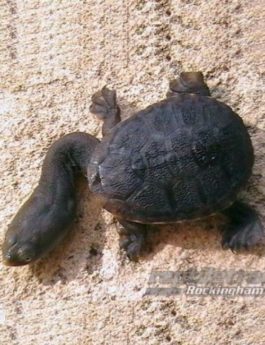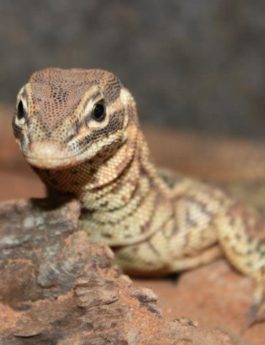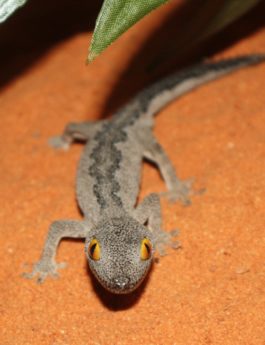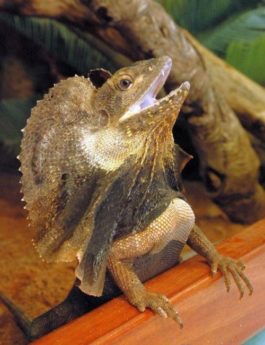The North-Western Red-Faced Turtle’s shell is a brown to blackish-brown colour on top, usually with obscure dark flecks and blotches. Underneath is a whitish colour, flushed with a pink or salmon tone which can be either faint or vivid. A temporal stripe usually salmon-coloured starts from the eye, and a stripe of the same colour starts from along the lower jaw back to the side of the neck. They have only moderately long necks, the extended head and neck much shorter than the length of their shell. They have five claws on each webbed forelimb.
You will find the North-West Red-Faced Turtle in deeper, slower moving stretches of rivers and creeks in the Kimberly region WA, northern NT.
Terrarium: North-Western Red-Faced Turtles require an aquatic style enclosure, this makes outdoor housing the preferred method of keeping them. An outdoor enclosure needs to be fully secure and escape proof, a pond of 120cmx120cm and at least 60cm deep would comfortably house three – four adult turtles. The pond and land areas should have access to direct sunlight and shade. An indoor enclosure that is 120x60x60 (WxDxH) would be suitable to house two adults, young turtles should be housed indoors in an appropriate sized enclosure. Any terrarium must include appropriate filtration to ensure the health of the turtles.
Lighting and Heating: If housing in an outdoor pond enclosure there is no need to provide artificial heat or light. When being housed indoors full spectrum UVB and a basking light must be provided, alongside a water heater. There are a number of ways to provide UVB, fluorescent 10.0 spectrum tubes or bulbs will provide UVB, a ‘daylight basking’ heat globe will have to be used in conjunction. A mercury vapour globe will provide intense UVA & UVB light, mercury vapour globes are in our opinion superior to fluorescents as it is a longer lasting globe with more intense UVB output, however they cannot be used with a thermostat so work better with a larger enclosure that will easier maintain a thermal gradient. During the day, you want to achieve a basking ‘Hot Spot’ of 35°C and an air temperature ranging from 35°C in the hot end, and down to 20-25°C in the cool end. To monitor the temperatures inside the enclosure a thermometer should always be used.
Furnishings: both indoor and outdoor enclosures should have multiple large logs in the water, these will provide hiding spots, and be the way to come up out of the water onto their basking site, which can either be a floating dock or a log with a large surface area out of the water. Large plants either living or artificial will provide coverage while in the water, in an outdoor enclosure these should be added to the land area as well. An aquarium gravel or large stones can be used as a substrate in the pond or terrarium, gravel or mulch can be used in the land area for the outdoor enclosure.
Food in captivity: there are frozen foods available that meet dietary requirements, along with these, turtles can eat a variety of insects, raw meats, mice and feeder fish.
The essentials:
- Aquarium/pond of appropriate size
- High spectrum UVB lighting (if indoors)
- Daytime Basking globe (if indoors)
- Thermometer
- Filtration system
- Substrate
- logs
- Foliage for shelter






